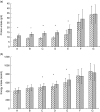Effect of dietary protein on plasma insulin-like growth factor-1, growth, and body composition in healthy term infants: a randomised, double-blind, controlled trial (Early Protein and Obesity in Childhood (EPOCH) study)
- PMID: 26586096
- PMCID: PMC4697297
- DOI: 10.1017/S0007114515004456
Effect of dietary protein on plasma insulin-like growth factor-1, growth, and body composition in healthy term infants: a randomised, double-blind, controlled trial (Early Protein and Obesity in Childhood (EPOCH) study)
Abstract
The effect of protein intake on growth velocity in infancy may be mediated by insulin-like growth factor-1 (IGF-1). This study aimed to determine the effects of formulae containing 1·8 (F1·8) or 2·7 g (F2·7) protein/418·4 kJ (100 kcal) on IGF-1 concentrations and growth. Healthy term infants were randomly assigned to receive F1·8 (n 74) or F2·7 (n 80) exclusively for the first 4 months of life. A group of breast-fed infants (n 84) was followed-up simultaneously (reference). Growth and body composition were measured at 0·5, 4, 6, 12, 36, 48 and 60 months of life. The IGF-1 concentrations at 4 months (primary outcome) were similar in the F1·8 (67·1 (sd 20·8) ng/l; n 70) and F2·7 (71·2 (sd 27·5) ng/l; n 73) groups (P=0·52). Both formula groups had higher IGF-1 concentrations than the breast-fed group at 4 and 9 months of age (P≤0·0001). During the first 60 months of life, anthropometric parameters in the F1·8 group were lower compared with the F2·7 group, and the differences were significant for head circumference from 2 to 60 months, body weight at 4 and 6 months and length at 9, 12 and 36 months of age. There were no significant differences in body composition between these two groups at any age. We conclude that, in formula-fed infants, although increased protein intake did not affect the IGF-1 concentration during the first 12 months of life, it did affect length and head circumference growth, suggesting that factors other than IGF-1 could play roles in determining growth velocity.
Keywords: AE adverse events; CHOP Childhood Obesity Project Study Group; DEXA dual energy X-ray absorptiometry; Dietary proteins; EPOCH Early Protein and Obesity in Childhood; Fat mass; Growth; IGF-1 insulin-like growth factor-1; IGFBP IGF-binding protein; ITT intention-to-treat; Infants; Obesity; SAE serious AE.
Figures


 )
or standard-protein (F2·7,
)
or standard-protein (F2·7,  ) formula. Values are means, with standard
deviations represented by vertical bars. * Significant difference between feeding
groups (P<0·05). To convert kcal/d to kJ/d, multiply by
4·184.
) formula. Values are means, with standard
deviations represented by vertical bars. * Significant difference between feeding
groups (P<0·05). To convert kcal/d to kJ/d, multiply by
4·184.
 ) or standard-protein formula (F2·7,
) or standard-protein formula (F2·7,
 ). Values are means, with standard
deviations represented by vertical bars. Upper and lower dotted lines indicate +2
). Values are means, with standard
deviations represented by vertical bars. Upper and lower dotted lines indicate +2
References
-
- Karaolis-Danckert N, Buyken AE, Bolzenius K, et al. (2006) Rapid growth among term children whose birth weight was appropriate for gestational age has a longer lasting effect on body fat percentage than on body mass index. Am J Clin Nutr 84, 1449–1455. - PubMed
-
- Ong KK, Emmett PM, Noble S, et al. (2006) Dietary energy intake at the age of 4 months predicts postnatal weight gain and childhood body mass index. Pediatrics 117, e503–e508. - PubMed
-
- Druet C, Stettler N, Sharp S, et al. (2012) Prediction of childhood obesity by infancy weight gain: an individual-level meta-analysis. Paediatr Perinat Epidemiol 26, 19–26. - PubMed
Publication types
MeSH terms
Substances
LinkOut - more resources
Full Text Sources
Medical
Research Materials
Miscellaneous

